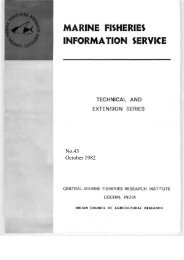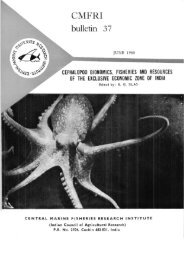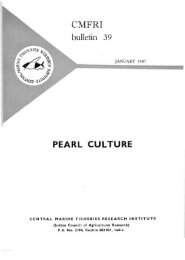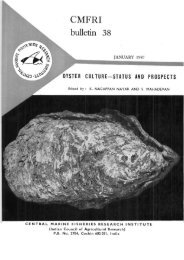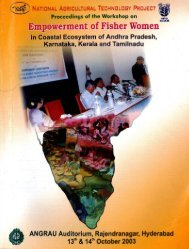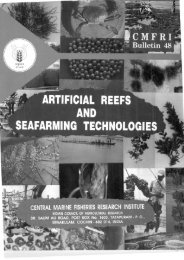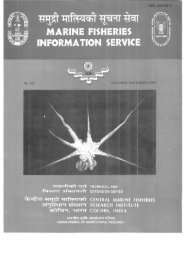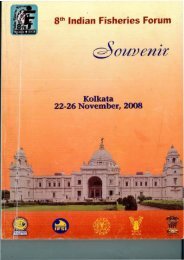60KISHINOUYE, K. 1919. Larval and juvenile tunas and skipjacks. Suisan Gakkai Ho, 3(2). (U.S.Dept. int. Fish and Wildl. Serv. Spl. Sci. Rept. No.19 Translated from Japanese by W.G.Van Campen).Larvae <strong>of</strong> Katsuwonous pelamis from 3 mm. to about 6 mm., Auxis sp. <strong>of</strong> 4 mm. and juvenile,63 mm. (Standard length) and <strong>of</strong> Neothunnus macropterus with figures.KLAWE, W.L. 1961a. Notes on larvae, juveniles and spawning <strong>of</strong> bonito (Sarda) from <strong>the</strong> easternPacific ocean. Pac. Sci., 15(4):487-493.Identification <strong>of</strong> <strong>the</strong> juvenile <strong>of</strong> Sarda orientalis.KLAWE, W.L. 1961b. Young <strong>of</strong> scombroids from <strong>the</strong> waters between Cape Hatteras and Bahamaislands. Bull. Mar. Sci. Gulf and Caribb., 11(1): 150-157.Young <strong>of</strong> Katsuwonus pelamis in total length from 25 to 42 mm. and Auxis thazard in total length11 and 13 mm. with figures and notes on spawning habits.KLAWE, W.L. 1963. Observations on <strong>the</strong> spawning <strong>of</strong> four species <strong>of</strong> tuna Neothunnus macropterus,Katsuwonus pelamis, Auxis thazard and Euthynnus lineatus in <strong>the</strong> eastern Pacific ocean based on <strong>the</strong>distribution <strong>of</strong> <strong>the</strong>ir larvae and juveniles. Bull. Inter-Am. Trop. Tuna Comm., 6(9): 449-514.Spawning, distribution <strong>of</strong> larvae and <strong>of</strong> juveniles <strong>of</strong> <strong>the</strong> four species.KLAWE, W.L. and M. SHIMADA 1959. Young scombroid fishes from <strong>the</strong> gulf <strong>of</strong> Mexico. Bull. Mar.Sci. Gulf. and Caribb., 9(1):100-115.Identification and description <strong>of</strong> <strong>the</strong> young stages <strong>of</strong> Katsuwonous pelamis and Auxis thazardare dealt with.KOWTAL, G.V. 1965. On <strong>the</strong> breeding <strong>of</strong> Eleu<strong>the</strong>ronema tetradactylum (Shaw) in <strong>the</strong> Chilka Lake.Sci. & Cult., 31(5):262-263.Breeding <strong>of</strong> <strong>the</strong> species in <strong>the</strong> lake and prolarvae and postlarvae till 5.5 mm. stage.KRISHNAMOORTHI, B. 1958. Observations on <strong>the</strong> spawning season and <strong>the</strong> fisheries <strong>of</strong> <strong>the</strong> spottedseer, Scomberomorus guttatus (Bloch and Schneider). Indian J. Fish., 5(2):270-281.Spawning season and minimum size at maturity.KRISHANMURTHI, K. 1962. Occurrence <strong>of</strong> a very early stage <strong>of</strong> Parapegasus natans (Linnaeus)from <strong>the</strong> nearshore waters <strong>of</strong> Porto Novo, South India. J. Mar. biol. Ass. India, 1961, 3(1&2): 271-272.6 mm. postlarvae with figure.KRISHNAYYA, CH. G. 1967. On <strong>the</strong> use <strong>of</strong> otoliths in <strong>the</strong> determination <strong>of</strong> age and growth <strong>of</strong> <strong>the</strong>Gangetic whiting, Sillago panijus (Hamilton Buchanan), with notes on its fishery in Hooghly estuary. Adv.Abstr. Contr. Fish. Aquat. Sci. India, 1(1): 13-14 (Also Indian J. Fish., 1963, 10A)Spawning and maturation <strong>of</strong> Sillago panijus.KULKARNI, C.V. 1940. On <strong>the</strong> systematic position, structural modifications, bionomics and development<strong>of</strong> remarkable new family <strong>of</strong> Cyprinodont fishes from <strong>the</strong> Province <strong>of</strong> Bombay. Rec. Indian Mus., 42(2):379-423.Fertilization <strong>of</strong> <strong>the</strong> eggs, mode <strong>of</strong> egg laying, description <strong>of</strong> <strong>the</strong> egg, development <strong>of</strong> <strong>the</strong> embryo,period <strong>of</strong> incubation, newly hatched larva, larval developmet till 10 mm. stage, and development <strong>of</strong> <strong>the</strong>gonopodium in Horaichthys setnai.
KULKARNI, C.V. 1943. Breeding habits and early stages <strong>of</strong> gourami (Osphronemus goramy Lacepede)J. Bombay nat. Hist. Soc. 44: 233-243.Breeding habits, breeding season, nest building, eggs, embryonic development, newly hatchedlarva, and stages till 9 days old with figures.KULKARNI, C.V. 1946. Gourami culture, Indian Fmg., 7(12): 565-571.Culture <strong>of</strong> Osphronemus goramy, breeding habits, nest, spawning, eggs and early larvae.KULKARNI, C.V. 1947. Notes on fresh water fishes <strong>of</strong> Bombay and Salsette islands, J. Bombaynat. Hist. Soc. 47(2): 319-326.Fingerlings <strong>of</strong> Megalops cyprinoides, Lates calcarifer, breeding <strong>of</strong> Glossogobius giuris, Barbussarana, Gambusia affinis, fingerlings <strong>of</strong> Osphronemus goramy, Etroplus suratensis, and Ophicephalusmarulius.KULKARNI, C.V. 1950. Breeding habits, eggs and early life history <strong>of</strong> <strong>the</strong> Indian shad, Hilsa ilisha(Hamilton) in <strong>the</strong> Narbada river. Proc. nat. Inst. Sci. India, 16(3): 169-176.Spawning grounds, range <strong>of</strong> migration ovarian eggs, embryonic development, newly hatched larvaand early larvae till 3 days with figures.KULSHRESHTHA, S.D. and T. MAJUPURIA 1957. Notes on <strong>the</strong> development <strong>of</strong> <strong>the</strong> carps Barbusstigma. Proc. 44 th Indian Sci. Congr. (Calcutta), Pt.3, Abstracts: 317.Development till postlarval stages.KURIAN, C.V. 1966. Spawning <strong>of</strong> Mugil cephalus. Indian Fmg., 15(2):10-11.Migration, spawning and availability <strong>of</strong> fry.KUTHALINGAM, M.D.K. 1956. Observations on <strong>the</strong> food and feeding habits <strong>of</strong> <strong>the</strong> Indian mackerel,Rastrelliger kanagurta (Russel). J. zool. Soc. India, 8(2):99-106.Food <strong>of</strong> postlarvae and <strong>the</strong> change to juvenile food habits.KUTHALINGAM, M.D.K. 1957. Life history and feeding habits <strong>of</strong> Cynoglossus lingua (Ham.Buch.). Ibid., 9(2):208-215. (Also Proc. 45 th Indian Sci. Congr., Madras, 1958, Pt.3, Abstracts: 368).Eggs, prolarvae, postlarvae, metamorphosis to juvenile condition, and food <strong>of</strong> <strong>the</strong> juveniles withfigures.KUTHALINGAM, M.D.K. 1958. Studies on postlarvae and feeding habits <strong>of</strong> some fishes found in <strong>the</strong>Madras Plankton. J. Madras univ., 28B: 1-11.Larvae <strong>of</strong> Elops saurus, Saurida sp., Stolephorus sp., Hemirhamphus sp., Ambassis sp., Gobiussp. and Megalops cyprinoides and <strong>the</strong>ir food.KUTHALINGAM, M.D.K. 1959a. A contribution to <strong>the</strong> life histories and feeding habits <strong>of</strong> horsemackerels,Megalaspis cordyla (Linn.) and Caranx mate (Cuv. and Val.) and notes on <strong>the</strong> effect <strong>of</strong>absence <strong>of</strong> light on <strong>the</strong> development and feeding habits <strong>of</strong> larvae and postlarvae <strong>of</strong> Megalaspis cordyla.Ibid., 29B(2): 79-96.Eggs and larvae till <strong>the</strong> 33 rd day after hatching <strong>of</strong> M. cordyla and eggs and larvae till <strong>the</strong> 38 th dayafter hatching <strong>of</strong> C. mate with figures.61
- Page 3 and 4:
I C A RBULLETIN OF THE CENTRAL MARI
- Page 5:
CONTENTSForeword … … i-iiAnnota
- Page 8 and 9:
iiomissions or mistakes if any. In
- Page 10 and 11:
2AHMAD, N. 1948a. On the spawning h
- Page 12 and 13:
4ALIKUNHI, K.H. 1948b. Food, feedin
- Page 14 and 15:
6ALIKUNHI, K.H. and G.L, RAO 1948.
- Page 16 and 17:
8ANONYMOUS 1949. Marine fisheries o
- Page 18 and 19: 10Bal and Pradhan, 1947 (Contd.)Occ
- Page 20 and 21: 12BAPAT, S.V. and D.V. BAL 1952. Th
- Page 22 and 23: 14BELSARE, D.K. 1964. Seasonal chan
- Page 24 and 25: 16BHOWMICK, R.M. 1966. Studies on s
- Page 26 and 27: 18CHACKO, P.I. 1950a. Spawning and
- Page 28 and 29: 20CHACKO, P.I. and S.V GANAPATI 194
- Page 30 and 31: 22CHACKO, P.I. and G.K. KURIYAN 194
- Page 32 and 33: 24Chaudhuri, 1916b (contd.)Breeding
- Page 34 and 35: 26CHIDAMBARAM, K. 1949. Comments on
- Page 36 and 37: 28DAS, B.K. and K.C. PATI 1966. Pre
- Page 38 and 39: 30DELSMAN, H.C. 1922a. Fish eggs an
- Page 40 and 41: 32DELSMAN, H.C. 1933a. Fish eggs an
- Page 42 and 43: 34DEVANESEN, D.W. and P.I. CHACKO 1
- Page 44 and 45: 36DURVE, V.S. and S.K. DHARMARAJA 1
- Page 46 and 47: 38GANAPATI, S.V. and K.H. ALIKUNHI
- Page 48 and 49: 40GOPALAKRISHNAN, V., R.N. PAL and
- Page 50 and 51: 42HASAN, R. and A.K. JAFRI 1964. A
- Page 52 and 53: 44HORA, S.L. and K.K NAIR 1943b. Po
- Page 54 and 55: 46JACOB, P.K and B. KRISHNAMURTHY 1
- Page 56 and 57: 48JOB, T.J. 1940. On the breeding a
- Page 58 and 59: 50JONES, S. 1937b. On the origin an
- Page 60 and 61: 52JONES, S. 1960c. Notes on eggs, l
- Page 62 and 63: 54JONES, S. and P.M.G MENON 1951a.
- Page 64 and 65: 56KADAM, K.M. 1956. The development
- Page 66 and 67: 58KHAN, H. 1929. Early stages in th
- Page 70 and 71: 62KUTHALINGAM, M.D.K. 1959b. Observ
- Page 72 and 73: 64MACKAY, W.S.S. 1945b. Trout of Tr
- Page 74 and 75: 66MAZUMDAR, S.R. 1957a. On the spaw
- Page 76 and 77: 68MITHRA, G.N. 1942. Rate of growth
- Page 78 and 79: 70MOOKERJEE, H.K. and R.N. BHATTACH
- Page 80 and 81: 72MOOKERJEE, H.K. and S.R. MAZUMDAR
- Page 82 and 83: 74NAIR, G.S. 1961. On the developme
- Page 84 and 85: 76NAIR, R.V. and K.H. MOHAMED 1961c
- Page 86 and 87: 78PALEKAR, V.C. and K.R. KARANDIKAR
- Page 88 and 89: 80PILLAI, S.R. 1964. Maturation and
- Page 90 and 91: 82PRABHU, M.S. 1956. Maturation of
- Page 92 and 93: 84QAYYUM, A. and S.Z. QASIM 1964a.
- Page 94 and 95: 86RAI, U.S. 1948b. Effect of the we
- Page 96 and 97: 88RAJU, G. 1963. Spawning of the oc
- Page 98 and 99: 90RAO, M. BABU 1965. Biological stu
- Page 100 and 101: 92SADASIVAN, V. 1953. Preliminary o
- Page 102 and 103: 94SARKAR, H.L. and N.K. KAUSHIK 195
- Page 104 and 105: 96SEKHARAN, K.V. 1965. On the macke
- Page 106 and 107: 98Sivaprakasam, 1965 (Contd.)Maturi
- Page 108 and 109: 100SRINIVASACHAR, H.R. 1957b. Devel
- Page 110 and 111: 102SUNDARARAJ, B.I. and L.S. RAMASW
- Page 112 and 113: 104THILLAYAMPALAM, F.M. 1948. Scoli
- Page 114 and 115: 106UPADHYAYA, M.P. 1956a. Survival
- Page 116 and 117: 108WEBER, M. and L.F. De BEAUFORT 1
- Page 118 and 119:
110YABE, H. 1951. Larva of the swor
- Page 120 and 121:
112Scoliodon sorrakowah (Contd.)Pri
- Page 122 and 123:
114Megalops cyprinoides (Contd.)Har
- Page 124 and 125:
116Sardinella longiceps (Contd.)Fam
- Page 126 and 127:
118Chanos chanos (Contd.)Fam. STOMI
- Page 128 and 129:
120Barbus (Puntius ) dubius (Contd.
- Page 130 and 131:
122Catla catla (Contd.) Chacko, 195
- Page 132 and 133:
124Labeo boga (Hamilton) Khan, 1923
- Page 134 and 135:
126Tachysurus jatius (Hamilton)Wall
- Page 136 and 137:
128Fam. ANGUILLIDAEFam. CONGRIDAEAn
- Page 138 and 139:
130Bregmaceros macclellandi (Contd.
- Page 140 and 141:
132Mugil parsia (Contd.)Valamugil (
- Page 142 and 143:
134Ambassis gymnocephalus (Lacepede
- Page 144 and 145:
136Decapterus russelli (Contd.)Gerr
- Page 146 and 147:
138Lethrinus nematacanthus Bleeker
- Page 148 and 149:
140Lepturacanthus savala (Contd.) P
- Page 150 and 151:
142Istiophorus gladius (Contd.) Day
- Page 152 and 153:
144Periophthalmus pearsi EggertJone
- Page 154 and 155:
146Tetrodon oblongus BleekerFam. AN
- Page 156 and 157:
148Etroplus 138, 139 Katsuwonus 141
- Page 158 and 159:
150Tinca 125 Uroconger 128Toxotes 1
- Page 160 and 161:
152External gills Ranada and Kevalr
- Page 162:
154Reproduction - general Khan and




